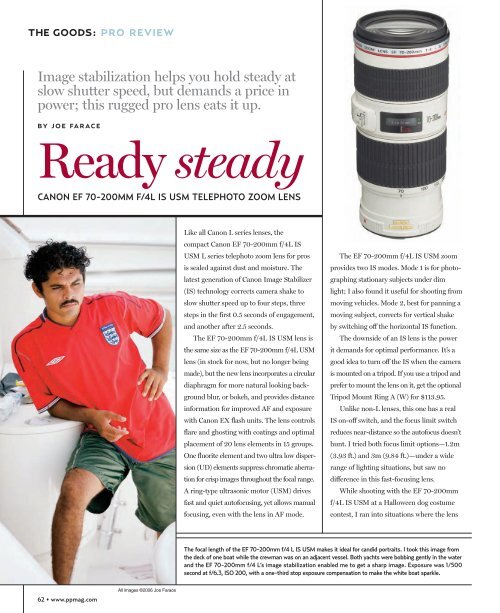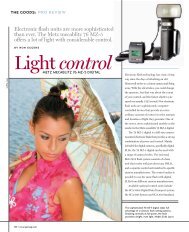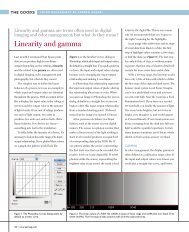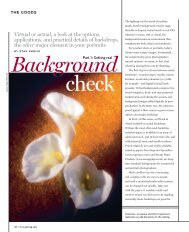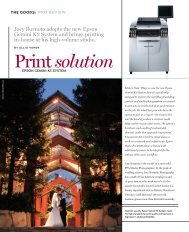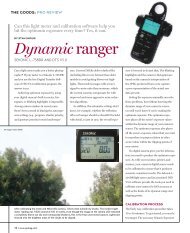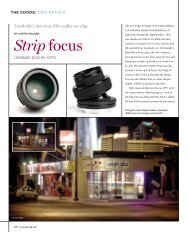january 2007 - Professional Photographer Magazine
january 2007 - Professional Photographer Magazine
january 2007 - Professional Photographer Magazine
Create successful ePaper yourself
Turn your PDF publications into a flip-book with our unique Google optimized e-Paper software.
THE GOODS: PRO REVIEW<br />
Image stabilization helps you hold steady at<br />
slow shutter speed, but demands a price in<br />
power; this rugged pro lens eats it up.<br />
BY JOE FARACE<br />
Ready steady<br />
CANON EF 70-200MM F/4L IS USM TELEPHOTO ZOOM LENS<br />
62 • www.ppmag.com<br />
All images ©2006 Joe Farace<br />
Like all Canon L series lenses, the<br />
compact Canon EF 70-200mm f/4L IS<br />
USM L series telephoto zoom lens for pros<br />
is sealed against dust and moisture. The<br />
latest generation of Canon Image Stabilizer<br />
(IS) technology corrects camera shake to<br />
slow shutter speed up to four steps, three<br />
steps in the first 0.5 seconds of engagement,<br />
and another after 2.5 seconds.<br />
The EF 70-200mm f/4L IS USM lens is<br />
the same size as the EF 70-200mm f/4L USM<br />
lens (in stock for now, but no longer being<br />
made), but the new lens incorporates a circular<br />
diaphragm for more natural looking background<br />
blur, or bokeh, and provides distance<br />
information for improved AF and exposure<br />
with Canon EX flash units. The lens controls<br />
flare and ghosting with coatings and optimal<br />
placement of 20 lens elements in 15 groups.<br />
One fluorite element and two ultra low dispersion<br />
(UD) elements suppress chromatic aberration<br />
for crisp images throughout the focal range.<br />
A ring-type ultrasonic motor (USM) drives<br />
fast and quiet autofocusing, yet allows manual<br />
focusing, even with the lens in AF mode.<br />
The EF 70-200mm f/4L IS USM zoom<br />
provides two IS modes. Mode 1 is for photographing<br />
stationary subjects under dim<br />
light; I also found it useful for shooting from<br />
moving vehicles. Mode 2, best for panning a<br />
moving subject, corrects for vertical shake<br />
by switching off the horizontal IS function.<br />
The downside of an IS lens is the power<br />
it demands for optimal performance. It’s a<br />
good idea to turn off the IS when the camera<br />
is mounted on a tripod. If you use a tripod and<br />
prefer to mount the lens on it, get the optional<br />
Tripod Mount Ring A (W) for $113.95.<br />
Unlike non-L lenses, this one has a real<br />
IS on-off switch, and the focus limit switch<br />
reduces near-distance so the autofocus doesn’t<br />
hunt. I tried both focus limit options—1.2m<br />
(3.93 ft.) and 3m (9.84 ft.)—under a wide<br />
range of lighting situations, but saw no<br />
difference in this fast-focusing lens.<br />
While shooting with the EF 70-200mm<br />
f/4L IS USM at a Halloween dog costume<br />
contest, I ran into situations where the lens<br />
The focal length of the EF 70-200mm f/4 L IS USM makes it ideal for candid portraits. I took this image from<br />
the deck of one boat while the crewman was on an adjacent vessel. Both yachts were bobbing gently in the water<br />
and the EF 70-200mm f/4 L’s image stabilization enabled me to get a sharp image. Exposure was 1/500<br />
second at f/6.3, ISO 200, with a one-third stop exposure compensation to make the white boat sparkle.


